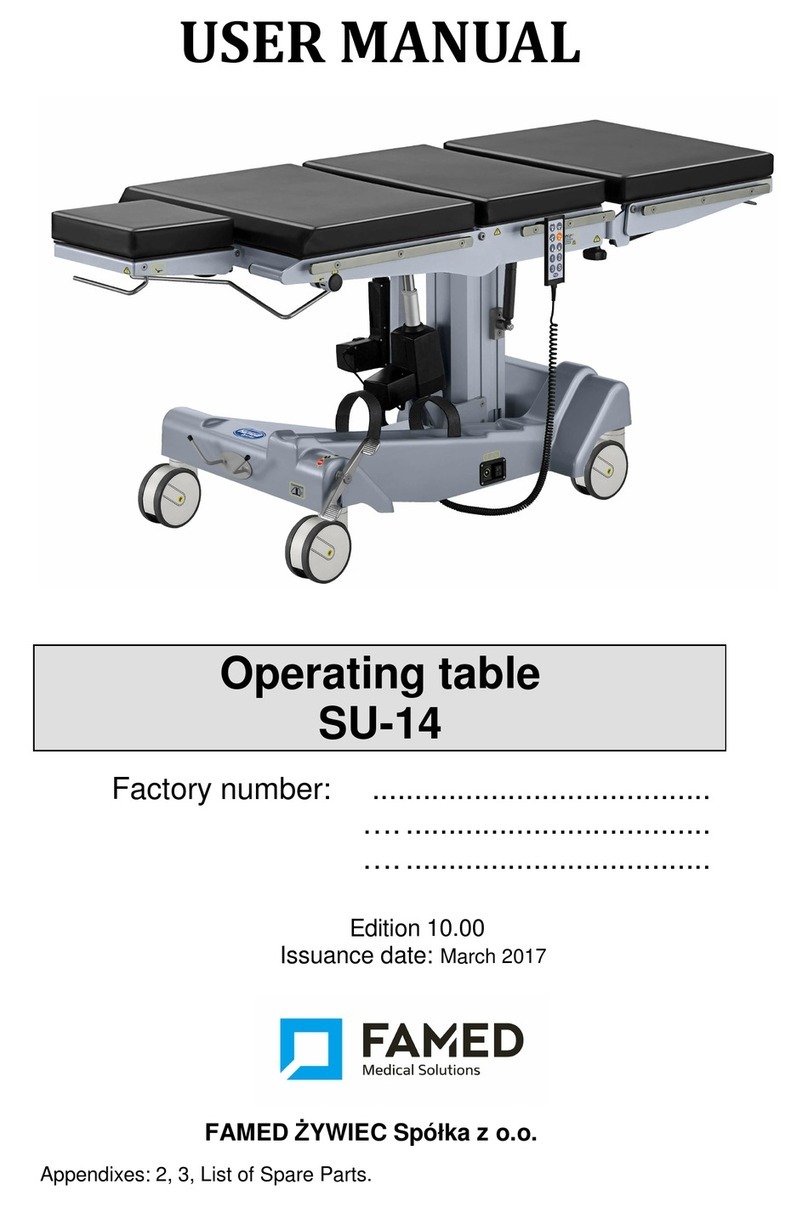
Operatin Manual for Operatin Table SU-02.0
_____________________________________________________________________________________________________
CONTENTS
1. PROPER USE AND APPLICATION ..............................................................................................................6
1.1. APPLICATION......................................................................................................................................................6
1.2. GENERAL REQUIREMENTS.....................................................................................................................................6
1.3. DUTIES OF THE USER ..........................................................................................................................................6
1.4 DESCRIPTION OF THE PRODUCT...............................................................................................................................6
1.5 DESCRIPTION OF ELEMENTS....................................................................................................................................7
1.6 TECHNICAL SPECIFICATIONS...................................................................................................................................9
1.7 USE PARAMETERS..............................................................................................................................................10
1.8 SAFETY............................................................................................................................................................11
1.9 CRITICAL PARAMETERS.......................................................................................................................................11
2 TRANSPORT AND FIRST USE......................................................................................................................12
2.1 TRANSPORT.......................................................................................................................................................12
2.2 UNPAC ING AND FIRST USE..................................................................................................................................12
3 OPERATION AND USE...................................................................................................................................13
3.1 RAISING AND LEVELLING OF TABLE TOP.................................................................................................................13
3.2 LONGITUDINAL TILT OF THE TABLE-TOP.................................................................................................................13
3.3 TABLE TOP SIDE INCLINATION...............................................................................................................................14
3.4 CHANGE OF ANGULAR POSITION OF THE BAC REST SEGMENT.....................................................................................14
3.5 CHANGE OF ANGULAR POSITION OF IDNEY BENCH .................................................................................................14
3.6 CHANGE OF ANGULAR POSITION OF THE FOOTRESTS.................................................................................................14
3.7 CHANGE OF ANGULAR POSITION OF DIVIDED FOOTRESTS ...........................................................................................15
3.8 ROTATION OF THE FOOTREST................................................................................................................................15
3.9 INSTALLATION AND REMOVAL OF THE FOOTREST......................................................................................................15
3.10 INSTALLATION AND OPERATION OF THE HEADREST.................................................................................................15
3.11 INSTALLATION AND DISMOUNTING OF MATTRESSES.................................................................................................16
3.12 TABLE MOBILITY..............................................................................................................................................16
3.13 ANTISTATIC PROPERTIES....................................................................................................................................16
3.14 POTENTIAL EQUALISING CLAMP ..........................................................................................................................16
3.15 COLLISIONS.....................................................................................................................................................17
4 INSTALLATION AND OPERATION OF ACCESSORIES.........................................................................18
5 CRITERIA ON WHOSE BASIS IT IS ASSESSED WHETHER PRODUCT OPERATION IS
CORRECT OR NOT............................................................................................................................................19
6 TABLE MAINTENANCE.................................................................................................................................19
6.1 STORAGE .........................................................................................................................................................19
6.2. CLEANING AND DISINFECTING ...........................................................................................................................20
6.3. DAMAGES AND DEFECTS.....................................................................................................................................20
6.4. REPAIRS AND INSPECTIONS..................................................................................................................................20
CONTROL OF TECHNICAL CONDITION...........................................................................................................................21
6.5. CONTROL OF TECHNICAL CONDITION.....................................................................................................................21
6.6. LOCATION OF DEFECTS AND THEIR REMOVAL.........................................................................................................21
6.7 PRODUCT LIQUIDATION.......................................................................................................................................22
7. TABLE IDENTIFICATION............................................................................................................................22
7.1. NAMEPLATE.....................................................................................................................................................22
7.2 LABELS...........................................................................................................................................................23
_________________________________________________________________________________
pa e 5




























